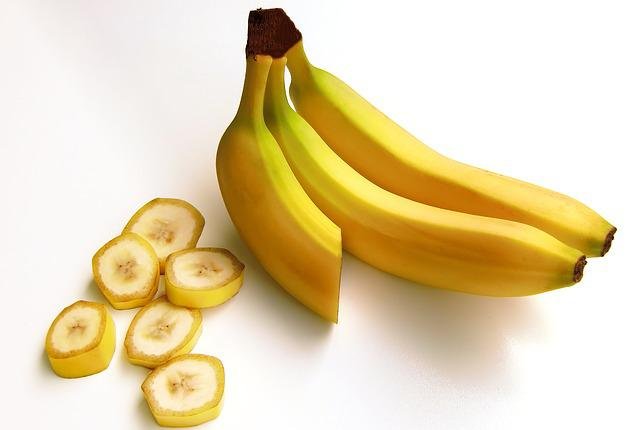
Bananas are among the most consumed fruits in the world and, thanks to their nutritional properties, they guarantee various health benefits.
Bananas are exotic fruits that are rich in properties and offer numerous health benefits. It is a fruit belonging to the Musaceae family and is among the most important food crops in the world.
Originating in Southeast Asia, today they are grown in at least 107 countries, thus ranking fourth among the world’s food crops in monetary value. In 2016, of the 545 thousand tons of exotic fruit consumed, 83% was represented by bananas.
The most popular type of banana is the smooth, yellow-skinned variety of varying sizes, which is usually eaten raw. The larger, green-colored bananas are known as plane trees and are usually eaten cooked in frying.
Among the benefits of bananas we find the reduction of abdominal swelling, the protection from the development of type 2 diabetes, the aid in weight loss and the strengthening of the immune system, but not only. We will learn more about all the properties of the banana later on. Let’s see now, instead, the characteristics and nutritional values of this fruit.
Banana: calories and nutritional values
First of all let’s see how many calories a banana has. As we can see in the table below relating to nutritional values, 100 grams of banana provide 89 calories, while a medium-sized banana provides about 105 calories.
From a nutritional point of view, the banana contains several minerals and vitamins. In particular, they are an excellent source of potassium and pectin (a particular fiber), while providing good amounts of vitamin B3, magnesium, phosphorus and vitamin C. Since bananas contain less water than most fruits, they provide more calories and they have a higher sugar content than other fruits, they bring about 12 grams of simple sugars out of 100 gr. Almost zero, however, the intake of fat, which is equal to 0.33%. We now report the table with the nutritional values of bananas in detail.
Nutritional values per 100g of banana:
- Waterfall: 74.91 g
- kcal: 89
- Proteins: 1.09 g
- Fat: 0.33 g
- of which saturated: 0.112 g
- Carbohydrates: 22.84 g
- of which sugars: 12.23 g
- Fibers: 2.6 g
- Potassium: 358 mg
- Magnesium: 27 mg
- Phosphorus: 22 mg
- C vitamin: 8.7 mg
- Vitamin B3: 358 mg
- Average glycemic index: 50
- Cholesterol: 0 g
Banana: nutritional properties
After taking a look at the nutritional values of these fruits, we see below the characteristics of the nutrients most represented in bananas.
- Carbohydrates: bananas are a good source of carbohydrates, the composition of which varies drastically during ripening; the main component of the unripe fruit is starch (70-80%) which, during ripening, is converted into sugars and ends up being less than 1% when the banana is fully ripe. The most common sugars found in ripe bananas are sucrose, fructose and glucose. Bananas have an average glycemic index that varies according to the degree of ripeness (42-58) and this is explained by their high content of resistant starch and fiber, which attenuate the post-prandial glycemic peak;
- Vitamin C: like all fruit, bananas also represent a source of vitamin C, an antioxidant molecule involved in numerous processes such as the reduction of oxidative stress, the strengthening of the immune and nervous systems, the formation of collagen and the absorption of food iron;
- Fiber: the types of fiber most present in bananas are resistant starch and pectin, both of which act in regulating glycemic levels after a meal and in increasing the sense of satiety;
- Potassium: bananas are an excellent source of potassium, one of the most important electrolytes in our body that mainly contributes to regulating heart function, fluid balance, muscle contraction and the response of nerve cells;
- Magnesium: regulates important organic reactions such as muscle contraction, the functioning of the nervous system and the hydro-saline balance;
- Phosphorus: mineral essential for the formation and maintenance of healthy teeth, bones and cells;
- Vitamin B3 (Niacin): micro-element that participates in digestive health and is involved in the reduction of cardiovascular and dermatological diseases;
- Catechins: Antioxidant flavonoids associated with several health benefits, including a reduced risk of cardiovascular disease.
Banana: health benefits
The richness of nutrients and its particular composition gives the banana beneficial properties for health, which can be different depending on the degree of ripeness of the fruit. In short, regardless of the degree of ripeness, bananas are good for the heart, are a rich source of potassium, are useful in weight loss (if consumed in the right quantities) and offer benefits to the digestive system, but not only. Let’s find out more about all the benefits.
✓ Different properties depending on the degree of ripeness
A 2017 meta-analysis suggested that unripe green bananas offer some health benefits: they would aid in the control of gastrointestinal problems such as diarrhea and ulcers, and help reduce cholesterol and blood pressure. On the other hand, according to a study, ripe bananas are eight times more effective in improving the power of white blood cells than unripe bananas, making them excellent allies in the battle against bacterial and fungal infections. viral and caused by other pathogens.
✓ Good for the heart
Bananas are rich in potassium, a mineral that promotes heart health and normal blood pressure. According to a meta-analysis, daily consumption of 1.3-1.4 grams of potassium is associated with a 26% lower risk of developing heart disease. In addition, the antioxidant flavonoids in bananas are also associated with a significant decrease in the risk of heart disease. Also, as we said above, these fruits are useful in keeping blood cholesterol levels under control.
✓ Prevention of asthma
A study, found that the consumption of just one banana a day in children would lead to a 34% reduction in the chance of developing asthma.
✓ Weight loss
Thanks to the presence of high quantities of resistant starch in less ripe bananas, a characteristic that involves the reduction of the glycemic index, their consumption improves the impact on glycemic levels, stimulates the sense of satiety, promotes a lower caloric intake over the course of the day, thus helping weight loss.
✓ Glycemic control
The pectin and resistant starch present in bananas work by regulating blood sugar levels after meals and also reduce appetite by slowing stomach emptying. Having an average glycemic index, the consumption of these fruits by healthy individuals should not cause significant spikes in glycemic levels.
✓ Reduction of abdominal swelling
Thanks to the presence of high amounts of potassium, which acts by regulating the levels of hydration and body electrolytes, the consumption of bananas reduces the accumulation of fluids within our body, causing a decrease in abdominal swelling.
✓ They improve digestion
Less ripe bananas contain considerable amounts of resistant starch and pectin, two types of dietary fiber which, acting as prebiotics, support the growth of beneficial gut bacteria leading to the formation of butyrate, a short-chain fatty acid that promotes intestinal health.
✓ Useful against gastritis
Thanks to their soothing effect and low acidity, bananas are also a useful food in case of gastritis. In this sense, therefore, they are preferable to more acidic fruits such as citrus fruits or kiwis.
✓ Memory retention and mood improvement
Among the properties of bananas we also find the beneficial effects on memory and mood. In particular, these fruits contain tryptophan, an amino acid that plays a role in preserving memory and raising mood.
How many bananas to eat
To guarantee all the benefits seen above, it is sufficient to eat one banana a day, which corresponds to a portion of fruit. If we are particularly fond of this fruit, however, we can also eat two a day. An excess of bananas, on the other hand, could cause annoying intestinal disorders. The best time to consume them is breakfast or as an energetic and satiating snack.
Bananas: how to use and store them
Bananas are available all year round, and unlike other fruits, the ripening process does not slow down with harvesting. They should be stored at room temperature, but be careful because the higher the temperature, the faster they will ripen. To slow down this process, bananas can be put in the refrigerator: the outer skin will darken but the pulp will remain intact and firm for longer. Instead, to encourage faster ripening, place the bananas in a paper bag at room temperature.
Here are some tips for adding bananas to your diet:
- Add a sliced banana to your breakfast cereal or oatmeal porridge;
- Ripe banana pulp can be used in the preparation of baked goods to replace oil and butter, but also to reduce the amount of added sugar. Banana puree will add moisture and a naturally sweet flavor to your muffins, cookies and cakes;
- Peel and freeze sliced bananas to add them to any smoothie;
- With bananas it is even possible to prepare an instant ice cream, better known as Nana Ice Cream;
- A banana can be a handy snack to take to school or work.
Banana peel is also edible and rich in nutrients, such as vitamin B6, fiber, protein and various bioactive compounds such as polyphenols and carotenoids. Before consuming it, however, it is essential to make sure you use bananas from organic farming (to minimize exposure to pesticides that may have been sprayed in the banana groves) and wash them thoroughly under running water.
Are bananas astringent or laxative?
We often wonder if bananas are astringent or laxative. In reality, depending on the degree of ripeness, their consumption has an opposite effect on the gastrointestinal level and, therefore, these fruits can be useful both against diarrhea and against constipation. In particular:
- Unripe bananas have astringent properties and are an excellent remedy for diarrhea thanks to the action of resistant starch which increases the volume and mass of the stool;
- Ripe bananas, on the other hand, have a laxative action.
Banana: contraindications and potential negative effects
Now let’s see what are the contraindications of bananas and in which cases it is good to limit their use.
- Hyperkalemia: Heart patients who take beta-blocker drugs should take moderate amounts of bananas to avoid developing hyperkalemia, a condition in which there is an excess of potassium in the blood;
- Diabetes: if the consumption of bananas can have a protective action against diabetes, in case of overt disease, the consumption of bananas must be moderate and limited only to unripe bananas that have a lower glycemic index than ripe ones.
Fun Fact
The inside of the banana peel can be rubbed into the skin to soothe the itchiness caused by the mosquito bite and thus reduce irritation.






